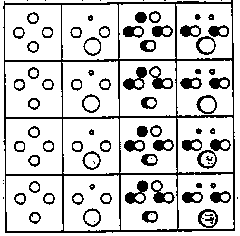|
Method of Motion Handedness |
|||
| Four elements are presented cyclically in either the clockwise or counterclockwise order. Arrows represent experienced trajectory when stimuli are presented clockwise at various rates. | |||
| When presentation rate is very slow, experienced trajectory is diamond shaped. | When presentation rate is just above threshold, experienced trajectory curves into a circle | When presentation rate is just below threshold, direction of presentation is indiscernible. | When presentation rate is very rapid, no motion is experienced. (just occasional blinking). |
 |
|||




